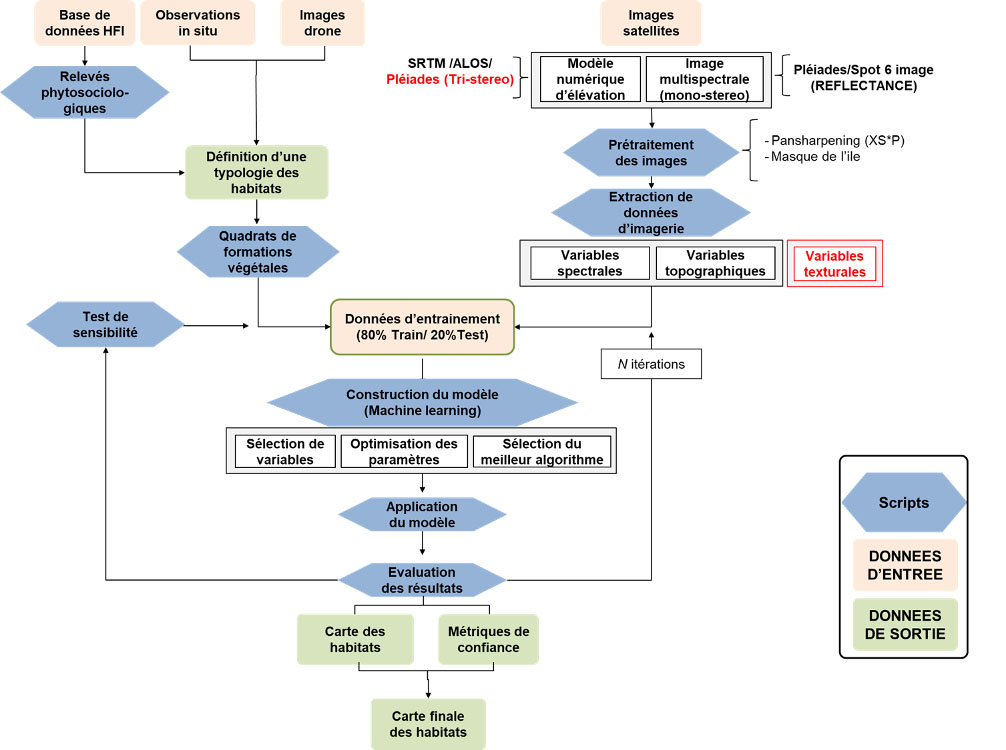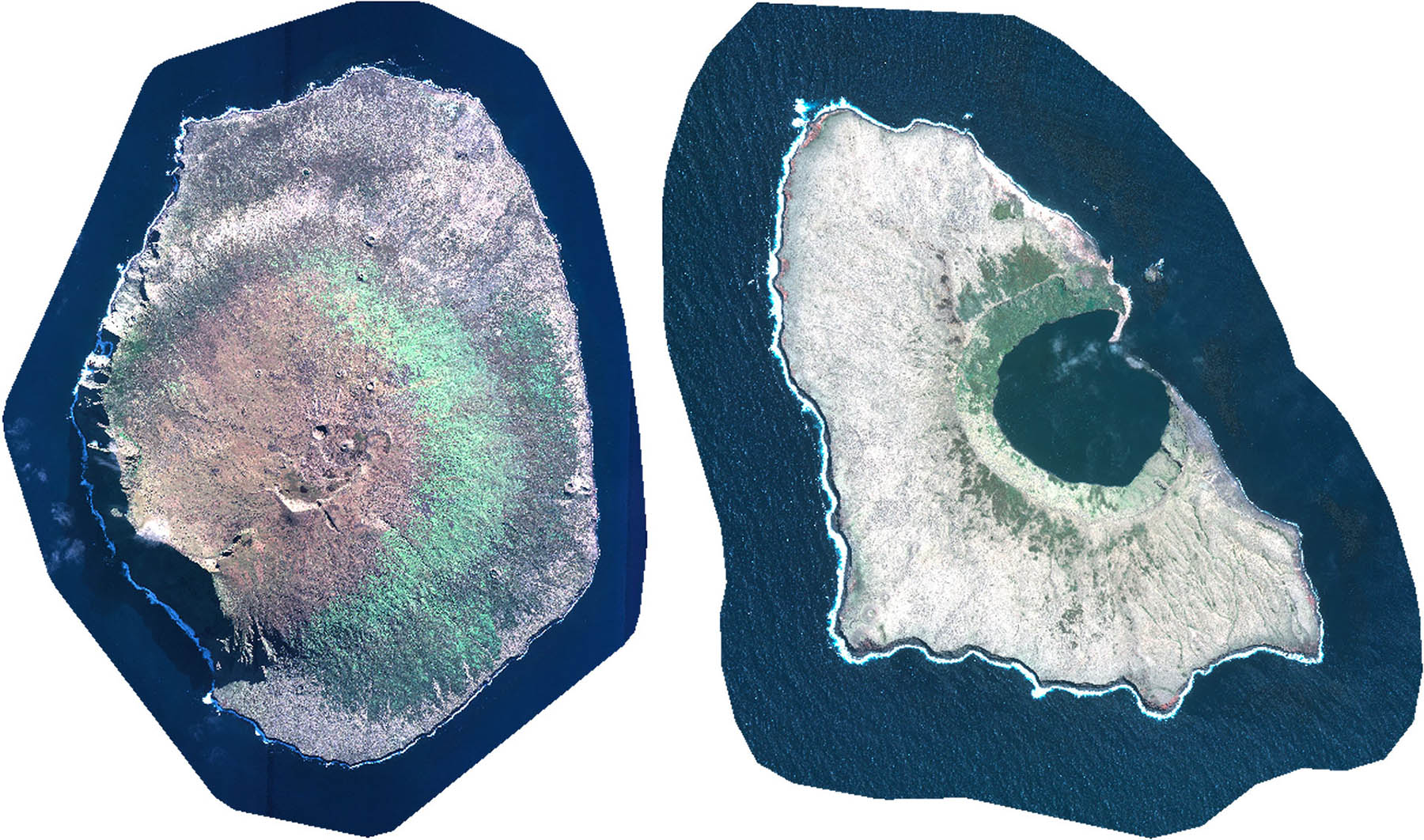CARTOVEGE 2
CARTOgraphy by remote sensing for the management and restoration of polar ecosystems: maps of plant formations and inference of the effects of global change on the occurrence of plant species
Overview
-
Context
The French Southern Territories, an integral part of a national nature reserve created in 2006 and a UNESCO World Heritage Site since 2019, are a focal point for biodiversity conservation (the highest bird density in the world, numerous endemic species, etc.).
They are made up of the Crozet and Kerguelen archipelagos and the islands of St Paul and Amsterdam, whose natural heritage is under threat from the introduction of exotic species and climate change, which are leading to a redistribution of species and changes to natural habitats, with repercussions for communities and the associated ecosystem services. To ensure better management and conservation of these areas, it is essential to improve our knowledge of terrestrial ecosystems and their spatial and temporal evolution.
An initial project with SCO-CNES accreditation in 2021, entitled CARTOVEGE1 implemented on the island of Possession (Crozet archipelago) with the support of the French Polar Institute (project 136-SUBANTECO) made it possible to :
- Defining the diversity of habitats in the Crozet Archipelago using a new typology adapted to polar tundra vegetation;
- Use this typology to propose an automatic processing chain for high-resolution satellite imagery to map the natural terrestrial habitats of these regions using supervised classification (machine learning).
The first applications of the processing chain have confirmed the decisive contribution of high-resolution satellite remote sensing to the mapping of natural habitats on the scale of the French Southern Territories National Nature Reserve (RNN TAF).
Nevertheless, although the three archipelagos share common habitats (e.g. peat bog environments found in Crozet and Amsterdam), the islands of St Paul and Amsterdam, located at lower latitudes, have certain plant physiognomies typical of subtropical zones (linked to the presence of shrub and tree strata) which require typological adjustments (identification of new habitat types) and cartographic adjustments (e.g. taking into account additional explanatory variables, such as texture, in the supervised classification).
-
The CARTOVEGE² project
In this new project, we propose to extend the work established in CARTOVEGE1 to the archipelago of the islands of Saint-Paul and Amsterdam, in order to improve the potential for transposing typological tools and habitat monitoring methods to other territories and to explore their potential.
The CARTOVEGE² project will meet the following three objectives:
-
The typology of habitats on the island of La Possession will be enriched and the remote sensing method will be adapted to integrate the plant formations of the different strata, and thus improve their distinction on the islands of St Paul and Amsterdam. By combining naturalist and environmental data with high spatial resolution multi-source drone and satellite imagery (Pléiades, Pléiades NEO, Spot 6/7), the monitoring tool will enable (i) scientists to study the effects of climate change and biological invasions on plant assemblages, and (ii) managers of the TAF RNN to assess vegetation dynamics.
-
In 2ème time, the remote sensing tool will provide spatial and temporal information on the habitats of the island of Amsterdam, which will reflect the impact of introduced mammal species on the environment, and their eradication (project to restore ecosystems in the Indian Ocean, RECI), which will be implemented in 2024. On the island of Amsterdam, hares and rodents pose a real threat to birds, through the transmission of disease or predation, and to endemic vegetation (e.g. Phylica arborea), through the consumption of seeds from native plants whose natural regeneration is slow or almost non-existent. CARTOVEGE2 will therefore be a unique opportunity to use satellite imagery to report on the impact on vegetation of restoration projects on such a large scale.
-
The habitat maps obtained will be used to feed plant species distribution models developed as part of two other research projects (the French Polar Institute's "136-SUBANTECO" project and the "ASICS - Biodiversa 2021-2024" project). These maps will improve the definition of parameters for predictive models designed to assess the future impact of climate change (rising temperatures, changes in rainfall patterns) on plant communities. The mapping of vegetation and habitats, and their future trajectories, will provide new knowledge for the scientific community, and will be important aids in the management of these islands.
Particular attention will be paid to the accessibility and use of these tools by managers (e.g. TAAF administration, national botanical conservatories, conservatories of natural and coastal areas).

Schematic representation of the field and imagery data processing chain developed as part of the SCO-CARTOVEGE project1 : the areas in red represent the tasks for which particular attention will be paid in order to ensure that they are improved and optimised within SCO-CARTOVEGE² so that the tool can be better transposed to other areas.
Application site(s)
Three islands in the French Southern Territories:
- Amsterdam Island, St Paul-Amsterdam archipelago
- St Paul Island, St Paul-Amsterdam archipelago
- Possession Island, Crozet archipelago
Data
Satellite
- High spatial resolution optical (multispectral) imaging: Pleiades, Spot 6/7 (Mono/Tri-Stereo)
- Radar imagery: Sentinel 1, SRTM
- Dinamis (Data Terra) and Copernicus infrastructures
Other
-
Drone: Aerial images (RGB): DJI AIR 2S
-
Weather data
- Time series of in-situ microclimatic data (SoilTemp)
-
High-resolution climate data (current and future) (French Polar Institute project 136-SUBANTECO, WorldClim, MerraClim, CHELSA, TerraClimate, Météo-France)
-
Floristic data
- Habitats-Flora-Invertebrates" database co-managed by the TAF National Nature Reserve and the French Polar Institute's 136-SUBANTECO project: this database compiles geo-referenced data over time and space on floristic surveys and associated environmental conditions (type of substrate, slope, altitude, soil moisture, etc.) in the French Southern Territories (Crozet, Kerguelen and Amsterdam).
-
Summer campaign(s) in Amsterdam: additional floristic data to (i) refine and validate the typology in Amsterdam; (ii) train and validate the Amsterdam habitat classification model.
-
Literature data
- Ecological knowledge: biological invasions, autoecology and synecology of native and non-native species, phytosociology.
- Knowledge of spatial modelling and remote sensing
- Knowledge of statistical processing: ascending hierarchical classification, clustering, etc.
- Habitat guides for the Crozet and Kerguelen archipelagos 2023
- Bibliographical summary of habitats on the sub-Antarctic islands
-
Literature on the flora of Amsterdam Island
-
Field monitoring tools
- Protocol for monitoring habitats by drone
-
Protocol for monitoring habitats by sampling points of contact
-
Statistical tools
- Satellite imagery processing chain developed in the SCO-CARTOVEGE 1 project
- Pixel-oriented classification models: machine learning (Random Forest, Support Vector Machine, etc.)
- Object-oriented classification models
- Automatic classification of vegetation surveys: automated criteria and classification methods using multivariate analysis and clustering
- Statistical interpolation (GWR 14 model) and topoclimate prediction
Programming language(s): R / Python
Database manager language : PostGre SQL
- Cartography/photogrammetry display tool
- Geographic information system software: QGIS
- Drone image stitching software (photogrammetry) : Agisoft Metashape
- Tool for hosting maps on CarHab
Results – Final product(s)
-
Database of georeferenced distribution data for the flora of Amsterdam Island, satellite images and microclimatic data used in habitat mapping.
-
Review of learning materials and habitat predictors.
-
Construction of a typology of plant formations on the island of Amsterdam (matching available naturalist data with the typology of habitats).
-
Mapping the habitats of Amsterdam Island by modelling plant formations on the basis of available material (naturalist data and explanatory variables).
-
Comparative mapping of habitats on Amsterdam Island: map of habitats before and after the cat and rodent eradication programme (RECI project).
-
Integration of habitat typology information into the HABREF database and the maps produced into the CarHab web platform.
-
Production of a habitat guide (plant formation classification reference system) for the St Paul-Amsterdam archipelago: identification key and summary sheets.
All the data and metadata on which the project and its publications are based will be published with a digital identifier (DOI) via the Dryad repository in accordance with the FAIR nomenclature and the 'Creative Commons Zero, CC0 1.0' framework.
The method developments obtained by programming will be stored in .m, .r or .txt format, and made public (GitHub).
Scientific publications will be deposited on open platforms (bioRxiv, Zenodo, HAL).
Efforts will be made to disseminate the results of this work to those responsible for managing biological invasions in France, using information-sharing tools developed by the IAS Resource Centre and the IAS Overseas Network (articles in newsletters, presentations at webinars, etc.).
References
 |
Cartovege2 on GEO Knowledge Hub, a long lasting digital repository created by the Group on Earth Observations: https://doi.org/10.60566/7pz26-dfy33 |
Related projects
-
SCO CARTOVEGE1 project (2021-2023)
-
RECI project ("Restoration of Indian Ocean Island Ecosystems")
-
Institut Polaire Français Paul-Emile Victor project 136-SUBANTECO (Subantarctic biodiversity, effects of climate change and biological invasions on the terrestrial biota',2022-2025) which deals in particular with the distribution of plant species (native and invasive) within the TAFs;
-
BiodivERsa 2021-2024 Biodiversity and Climate Change 'ASICS' project (ASsessing and mitigating the effects of climate change and biological Invasions on the spatial redistribution of biodiversity in Cold environmentS), the aim of which is to carry out predictive modelling of the distribution of flora at the scale of polar and alpine regions, under different climate change scenarios.
-
SoilTemp: a global database of soil and surface microclimatic data
-
INEE-CNRS Antarctic and Austral Territories Workshop Zone: long-term monitoring of Antarctic and sub-Antarctic biodiversity and ecosystems.
-
CarHab, a national mapping programme for natural and semi-natural habitats carried out in collaboration with the OFB (Office Français de la Biodiversité), PatriNat (MNHN-OFB-CNRS-IRD), a centre for expertise and data on natural heritage, and the IGN (Institut national de l'information géographique et forestière), the CBN (national botanical conservatories), the EVS laboratory (UMR 5600, Jean Monnet Saint-Etienne University), the CESBIO (Centre d'Etudes Spatiales de la Biosphère), the CEREMA (Centre d'études et d'expertise sur les risques, l'environnement, la mobilité et l'aménagement) and the BRGM (Bureau de recherches géologiques et minières).
-
SCO Space4Nature, satellites and AI to map habitats in the UK
Project news
- 24/04/2025 : Cartovege2: Mission Amsterdam
- 05/03/2024 : Transition for Cartovege











